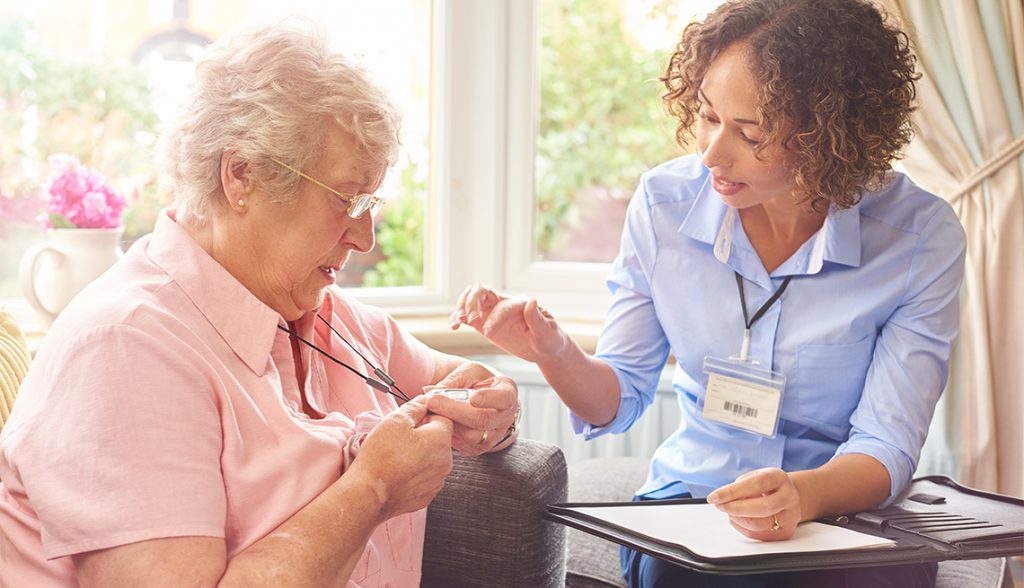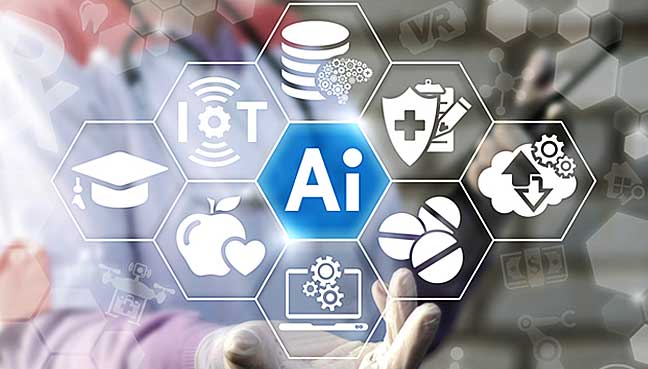Innovative technology brings real change in dementia care
Caregivers play a fundamental role in looking after people suffering from dementia, Alzheimer’s, Parkinson’s and other cognitive illnesses. They often have close personal relationships with service users and their families and are intimately involved in their families.
At the same time, agencies are under increasing pressure to increase service quality against a background of public sector budget cuts. That’s why new technological solutions are in growing demand.
We see these technologies as ways to complement and supplement face-to-face contact – not replace it. People with dementia can be given tools that increase their safety and security, let them stay independent for longer, and make coping with illness a little easier.
New apps, wearables and services
Exciting technological innovations are expanding the options available to caregivers. New services can be offered and increasingly tailored care plans are becoming commercially viable.
Opt-in apps and devices that collect, measure and analyse data can flag up issues sooner, letting carers and clinicians respond sooner and adjust plans accordingly. Smart, holistic services augmented through technology can also help agencies to personalise their services. This increases quality and creates value without significantly increasing costs.
Apps are now available for setting reminders for daily tasks like locking the front door or taking medication. Some offer automated notifications that tell carers when something has been done or missed, reducing response time when things go wrong.
Other apps give carers the opportunity to create profiles for the people in patients’ lives, where details are recorded about how they know someone, the different facets of that relationship, and key information to anchor conversations. Technology for reminiscence also facilitates discussion by bringing to life historical events such as famous sports matches.
As awareness grows, new online platforms are launching designed for people to rate a place’s dementia-friendliness make it easier for caregivers to successfully organise trips, confident that adequate facilities will be in place when they get there.
Advances in wearable technology means increasingly discreet ways for people to carry GPS tracking, which alerts carers should someone become lost. Shoes, jackets and other items can all be fitted with these devices, and services can be programmed to contact the right person automatically. Contact information and identification can also easily be encoded in objects like bracelets.
This all reduces self-consciousness and helps to overcome resistance, and avoids stigma – perceived or real – to using wearables in public.
A bright future
Many of these new technologies mean that collaboration between agencies can be greatly improved with opt-in data sharing to reduce duplication and ensure caregivers to stay coordinated, either within a single agency or across multiple organisations.
At the cutting edge, research and development in machine learning and AI has huge potential to create technology that can understand and analyse patterns of behaviour, before intelligently anticipating patient needs.
All in all, it is an exciting time for technology in dementia healthcare. Despite financial and demographic pressures from an ageing population, a significant shift toward more patient-centric care and transformational technology are offering opportunities to make care smarter, more responsive and keep people independent for longer.
Author: Eva Lajko

AI needs a new digital workforce
Artificial intelligence (AI) will be embedded in everything we know in the healthcare system: it is going to help surgeries, will make patient recovery easier, it will help in our decisions regarding finances, administration, HR in the healthcare system. AI will allow us to focus on the high-value items. The low-value items will be taken care of machine learning and artificial intelligence.
To this future become a reality we need a digital workforce in the healthcare system too. This digital workforce will need to have a workforce skillset suitable for the era of AI. According to Sam Hanna, associate dean of graduate and professional studies and program director in healthcare management at American University, Washington D.C. people good at strategical thinking have a chance of succeeding in this new workforce. They, of course, will need to understand a little bit of source code, but more important, they need to ask the question why I am doing what I’m doing, they need to understand the tactics. So, it is no longer suitable for a graduate from a master program to only use a specific tool, because that tool would be obsolete in two years. A valuable member of the digital workforce needs to learn about processes, systems, requires strategical thinking, tactical knowledge.
When we talk about all different technologies all comes down to how we train people, what kind of tools, techniques, languages they are learning so they can analyze the right data and come up with the right solution. This is just the knowledge component. Healthcare professionals also need to know why they are analyzing patient data. It’s a big mistake to jump right into the how phase, to shoot into the dark and take whatever solution emerges. You need to define a hypothesis, gather the right data, analyze them and then draw your personalized conclusion. The amount of data available is also overwhelming, and you, as a healthcare professional must discern the right data, in the right amount. This data allows us to have a much better holistic view of our patient, to create targeted therapies.
We fully understand those healthcare professionals who received their training 40 years are not skilled in this area. Health technology companies like us play a crucial role: we need to translate this knowledge to them in a way that is not scary. It may sound easy, but it is not, I assure you. It is a complicated process, that takes a long time. Moreover, do not forget, healthcare clinicians only make up about 20% of the workforce in the healthcare system, and in the remaining 80% – in administration, finance, HR – AI also plays a significant role. A whole new field to tackle with, entire new challenges to take on.
NETIS, as a Microsoft Silver Partner, recommends Microsoft’s Azure AI services.
Author: Zoltan Gelencser

Healthcare data everywhere – How can we manage data collected by digital tools?
Healthcare data involves a wide variety of public and private data collection systems such as enrollment and billing records, health surveys, medical records, and administrative enrollment records. Physicians, hospitals, and health plans heavily rely upon this information when managing and treating patients.
Digital tools have completely revolutionized the way patient data is collected. Take online patient portals for instance which allow patients to access health information easily, request prescription refills, make appointments, and exchange messages with providers in an all-in-one online platform.
There is also secure text messaging (STM), a method many providers have used to remind patients of upcoming appointments and collect vital information. Because texting has become such a massive facet of our lives it should come as no surprise that providers have taken advantage of this consumer preference.
The healthcare industry has grown remarkably complex over the past few decades and the need for effective data management, collected by digital tools, is more important now than ever before. When managed correctly, this data is often the key to improved patient engagement.
Managing data collection the right way
Frankly, there’s no single all-encompassing way to manage customer data. Specific digital tools must be used for particular tasks performed by providers. It is the task itself that will help healthcare providers to determine the best data collection methods.
To help improve this process, there are a few questions that need to be answered:
What tools are required to get the job done?
Who will be responsible for collecting the information?
What data do you need to collect?
Do tools already exist that are well suited for your purposes?
Are there any templates or tool samples available?
Answering the above questions should clarify the best methods needed to collect data in the most efficient way possible. Take for example, using a database such as Microsoft Excel to manage data for customers who require monthly prescription medication. Customer data can be arranged neatly into rows and columns which makes it easier for medical providers to make sense of the information when needed.
Digital tools empower patients
At the root of it all, digital tools do more than streamline the healthcare experience for patients; it empowers them as well. Due to the advent of telemedicine it’s now easier than ever to recover in the comfort of your own home which eliminates travel costs, wait times, and provides convenience of the highest degree.
Digital tools also allow for more efficient appointments. Mobile apps such as DocASAP and ZocDoc (used in the US) simplify the process of finding physicians who are ready to book appointments. Similar services like Push Doctor, or GP at Hand gaining popularity in the UK.
The future of data collection in healthcare
The healthcare industry is evolving practically every day and requires efficient data collection and management. Answering vital questions, who owns the collected data and who gives permission to use them and for what purposes is a must. Also, important questions are what the specific tools needed to perform a specific task (take appointment apps for example) and the type of data that needs to be collected will not only improve healthcare data collection efforts but also improve the level of care offered to patients.
Healthcare data is a sensitive personal data. Managing such data is heavily regulated (GDPR is not the only regulation, which needs to be observed). While healthcare industry is becoming data-driven, security and accuracy of such data is key as well as clear guidance who can get access to this data and how data is managed on the long-term.
Author: Eva Lajko

How technology is changing dementia care in the home
Just as technology increasingly features in everyday home life, advances in ICT are presenting major opportunities to advance the delivery of health care for dementia and Alzheimer’s patients in their own homes.
Helping people stay in their own homes for longer is a key objective for patients, families and healthcare professionals. Being cared for at home usually means more autonomy for the individual but must be balanced safety considerations. As the disease progresses, the risks of living alone at home increase significantly.
Innovations are unlocking new ways of extending the time people are able to stay autonomous by mitigating risks and empowering sufferers to play a more active role in their own care. They are also giving families, healthcare professionals and service providers new tools for delivering high-quality patient-centric care.
New apps and wearables are helping to integrate care discreetly and efficiently into daily life. GPS trackers in shoes, smartphone apps and online platforms that let patients and families rate places for dementia-friendliness are all making coping with early and intermediary stage symptoms easier.
Remote patient monitoring has a central role
Giving reassurance to healthcare professionals that patients have successfully completed daily tasks like locking the front door or turning off the oven means lower risk and better-targeted interventions.
Remote monitoring also helps clinicians and families to identify problems sooner and means that face to face time can be spent more effectively, driving up quality at the same time as driving down costs.
Better data for better results
Especially early on, clinicians are dealing with very few data points, gathered through infrequent face-to-face contact. By introducing technological solutions at the outset, issues are more likely to be identified quickly.
Systems for sharing data are also key. By automatically sending the right data to the right person at the right time – whether that is a neighbor, family member, clinician or service provider, the quality of care can be improved.
Letting a neighbor, for example, know that the patient has missed a check-in means an investigation can be carried out quickly by a familiar face, which either gives reassurance or allows the alarm to be raised sooner than with traditionally scheduled visits.
Working in this way, not only can care be improved, but costs can simultaneously be reduced.
Building technology-assisted safety nets
Creating a more effective safety net around a patient also gives them more confidence to live independently, knowing that help and support are readily available should something go wrong. Automated alert systems and data sharing mean the alarm can be raised quickly with the right person. That means people can live fuller lives for longer because fear is lessened.
In general, individuals prefer to be cared for at home, and innovations in technology for dementia and Alzheimer’s care is allowing the creating of increasingly accurate and tailored healthcare plans that allow that.
Well integrated into patient-centric care, we see new technology and connectedness as a means of empowering individual patients to live more independent lives and stay at home for longer. It also allows clinicians to deal with budgetary pressures and an ageing population without the significant investment that would normally require.
Author: Laszlo Varga

Personalized medicine for better health
In the summer of 2018, a US a teenager’s story about a lifesaving Apple Watch alert made it to the national headlines. The seemingly healthy 18 years old girl was sitting in church when the watch alerted her: the heart rate is extremely high. Her parents rushed her to the hospital, where they found out that she had kidney failure, with both of her kidneys functioning below 30%. Doctors diagnosed her with chronic kidney disease. Her caregiver admitted that the alert led the girl to the hospital, where doctors discovered her condition before dialysis or kidney transplant was needed to save her life.
These headlines help the marketing of fitness devices, but they also pave the way for personalized, evidence-based medicine. It uses stored health data, namely of patient diagnoses, laboratory work, insurance claims, and demographic information among others. This information allows to move beyond the reactive, one-size-fits-all approach of the 20th century’ method of treating illness, allowing healthcare provider to predict and prevent future diseases. (Harvey, A., Brand, A., Holgate, S.T., Kristiansen, L.V., Lehrach, H., Palotie, A., Prainsack, B.: The future of technologies for personalised medicine, 2012)
Personalized medicine offers a new approach to manage the patient’s health and target therapies better to achieve the best outcome for that particular patient. Data is collected and stored to control an existing, known disease of a patient or even a predisposition to a specific disease. Just like in our example: early detection of symptoms made possible for the teenage girl to discover her chronic disease before things turned worse.
We can take this one step further, and combine sensor provided health data with genomic technologies, that are already used widely to offer better outcomes to patients. Beside prediction and prevention of particular diseases data allows healthcare providers to form a more precise diagnose. The cause of shared symptoms could be different for each patient. If a doctor can pinpoint the exact cause of the symptom, he can form a more accurate diagnose.
Personalized medicine offers the possibility to move away from the “trial-and-error” method, prescribing the optimal therapy first time around. The current pharmaceutical interventions are effective in only 30-60% of patients due to differences in individual reactions and responses. If we map out the genetic variants responsible for personal drug response, we can use that knowledge to create a person’s pharmacogenomic profile and to identify optimal treatment.
For example, doctors treat a newly diagnosed Type 1 diabetes with regular insulin injections. However, there are some forms of diabetes, that have different underlying causes, but clinically looks like a classic Type 1 diabetes. A simple genetic test can identify some patients who can be better treated with tablets or who are best managed by no treatment at all – preventing all risks associated with poorly controlled diabetes.
When data is available the patient has a more participatory role in forming the diagnose and deciding what therapy may help. Healthcare professionals and patients discuss and interpret together information about individual genomic characteristics, lifestyle, and environmental factors, personal data from wearable technology. They consider lifestyle changes together and decide when treatments might not be necessary at all. Patients consider preventative measures, even when there is only a likelihood of a disease developing. A real doctor-patient dialogue opens, with one goal: better health.
Author: Laszlo Varga
